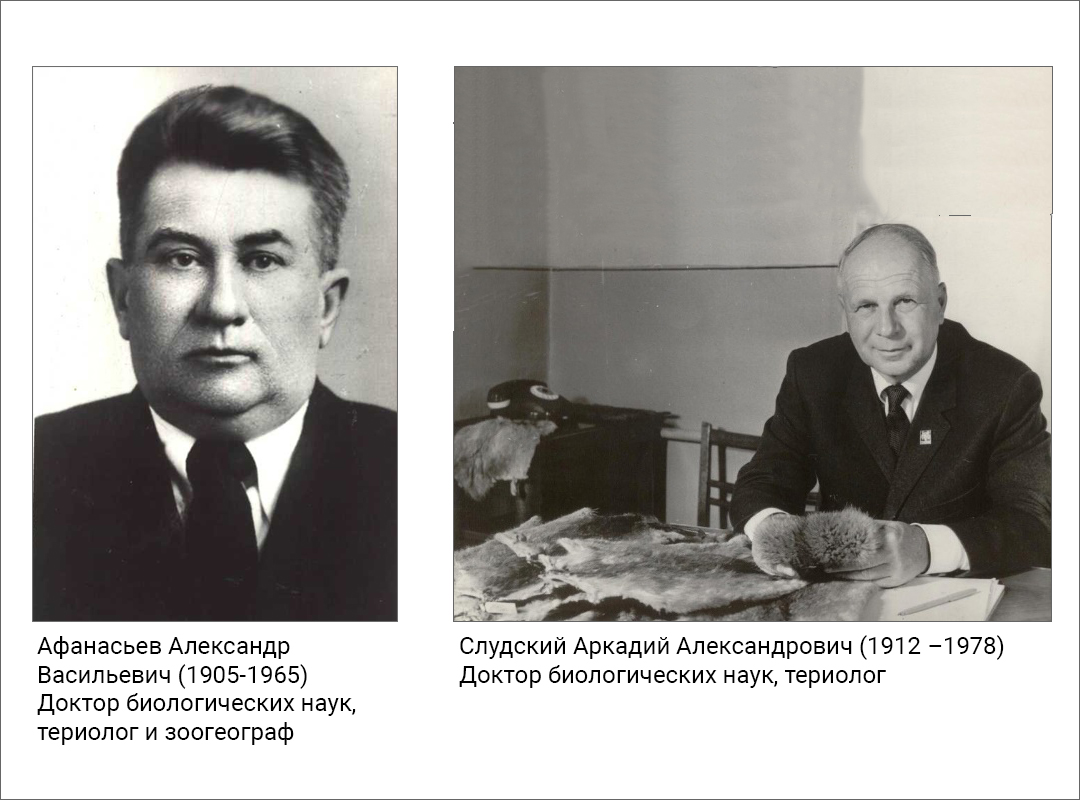The Laboratory of Theriology is one of the oldest in the Institute, organized in 1944 (in 1946-1962 it was called Laboratory of Zoogeography and Ecology of Mammals, and in 1963-1989 – Laboratory of Mammals). Great merits in its organization and development of researches on the study of animals inhabiting the republic belong to the late Doctor of Biology A.V. Afanasyev and Corresponding Member of the KazSSR Academy of Sciences A.A. Sludsky.

Until 1977 this laboratory was headed by A. A. Sludsky. At present it is headed by A. A. Grachev.
In the same laboratory worked V. S. Bazhanov and M. I. Ismagilov, PhDs V. M. Antipin, E. I. Strautman, E. F. Savinov, P. M. Antipin, E. I. Stroutman, E. F. Savinov, P. M. Butovsky, J. Myrzabekov, V. A. Borisenko, O. E. Tsaplyuk, A. A. Lazarev, Y. G. Afanasyev, V. I. Kapitonov, X. K. Kydirbayev, I. G. Shubin, V. A. Fadeev, A. K. Fedosenko, as well as researchers G. I. Orlov, V. I. Shubin. leading and senior researchers, candidates of biology Y. S. Lobachev, Y. A. Grachev, V. N. Mazin, B. Yeszhanov, researchers R. J. Baidavletov, L. V. Spivakova, B. B. Kasabekov, V. N. Murzov, K. S. Musabekov, R. T. Shaymardanov.
Since its organization, the laboratory has been engaged in studying the species composition, distribution and practical importance of mammals, organizing these works in regions of the republic that have not been visited by zoologists for a long time. In the 40s, faunistic work was carried out in the Southern Altai and Zaisan hollow, where a new species for science – the Altai gray mouse and, for the first time in Kazakhstan, the three-toed pygmy fat-tailed jerboa were found.
А. Afanasyev spent many years of expeditionary research in the Southern Pribalkhashye, Priirtyshye, Northern and Central Kazakhstan. From the Southern Pribalkhash, he described the Iliya narrow-crested vole, and from Central Kazakhstan, together with A.I. Argyropulo, the Central Kazakhstani red vole. In Northern Kazakhstan he discovered the common hedgehog and wood mouse, which added to the list of animals of the republic. In the Zaisan hollow he found the yellow tern, which occupied semi-deserts and northern deserts of the republic from Ustyurt to the Zaisan hollow in the early 19th century and then disappeared in this territory.
The study of the accumulated materials on mammals of Kazakhstan allowed A.V. Afanas’ev to develop a number of theoretical questions: to substantiate the existence of three original centers of formations (steppe, desert and mountain) in the territory of the republic and the relationship between Kazakh and Mongolian animal complexes, to develop zoogeographic zoning of Kazakhstan based on mammal distribution, which has not lost its importance up to the present.
In the 1940s, interesting studies and observations on mammals were conducted by V. M. Antipin and V. S. Bazhanov. S. Bazhanov. The first of them studied ungulates, in particular wild rams, the second studied rodents, mainly gophers.
A.A. Sludsky made many discoveries of animals and birds, clarifying their distribution in the republic, traced the diaemic boundaries of the ranges of several species of animals (elk, roe deer, wild boar, corsac, sand gopher, etc.) and clarified the factors that cause these changes. He made a great contribution to the problem of acclimatization of animals, especially muskrat. He directly organized the import of this rodent into the country, studied biological adaptations of muskrat in peculiar water bodies of Kazakhstan and the republics of Central Asia.
In the 50’s Kazakhstan was the number one producer of muskrat in the USSR, and the maximum yield of this animal in 1956 reached 2012.9 thousand animals. Successfully settled in the republic American mink, expanded the habitats of sand gopher, russack hare and other animals. Kulans, exterminated in the republic at the beginning of the current century, were brought to the island of Barsa-Kelmes.
A long-term study of saiga ecology and the conditions contributing to the population of this animal has been particularly important for the hunting industry of the republic. It has been established that saigas are characterized by early sexual maturity of females (about 7 months) and high fecundity. Based on a detailed study of saiga biology, scientifically substantiated recommendations for the timing and rational use of the commercial herd of animals have been developed. It has been proved that up to 20% of saigas can be shot without detriment to reproduction, which in some years amounted to 250-300 thousand animals.
The total value of saiga products (meat, hides, and horns) from 1955 to 1980 was 78 million rubles. For the scientific development of rational methods of saiga use and procurement, the laboratory staff of A. A. Sludsky, V.A. Fadeev and A. Bekenov were awarded the 1982 State Prize of the Republic of Kazakhstan in Science and Technology.
As a result of the study of the fauna, the ecology and practical importance of mammals in the early 50s the monograph “Beasts of Kazakhstan” (1953) was published, which described the distribution, lifestyle and economic importance of this group of animals.
Further research of the laboratory is associated with the clarification of the modern distribution of animals and the study of their adaptation to the changed conditions of existence in connection with the development of virgin and fallow lands. At that time, the ecology of a number of mammal species was studied. Thus, A.A. Sludsky published a monograph “Wild Boar” (1956), which contains many new original data on the life of wild boar in different regions of Kazakhstan, A.V. Afanasiev published a major work “Zoogeography of Kazakhstan” (1960). M. I. Ismagilov published a monograph “The Ecology of Rodents in Betpak-Dala and the Southern Balkhash” (1961), E. I. Strautman published a book “The muskrat in Kazakhstan” (1963) and A. K. Fedosenko prepared and published a monograph “The Maral” (1960). The results of recent studies on saiga populations are set out in a monograph by V. A. Fadeev and A. Sludsky, “Saiga in Kazakhstan” (1982).
Along with a detailed study of individual species important in practical terms, the laboratory continued to study the number and ecology of mammals in conditions of intensive development of natural complexes for the needs of the economy.
In 1985, completed a four-volume fundamental summary of the “Mammals of Kazakhstan” (1969-1985), which summarized the original materials and literary information accumulated over the past 50 years. This monograph was highly appreciated by the scientific community of the country. In 1988, a group of authors (R.Zh. Baidavletov, A.Bekenov, A.D. Bernstein, V.I. Kapitonov, M.I. Ismagilov, Yu.S. Lobachev, Yu.A. Grachev, A.A. Sludsky, E.I. Strautman, V.N. Varshavsky, V.A. Fadeev, A.K. Fedosenko) was awarded the first prize of the Moscow Society of Nature Testers for the best work in the field of natural history.
А. A. A. Sludsky participated in the compilation of the multi-volume monograph “Mammals of the Soviet Union. He wrote essays on the biology of the red wolf, jackal, and corsac (vol. II, part 1, 1967) and, together with V. G. Geptner, prepared a section describing cats (vol. II, part 2, 1972).
The laboratory staff performed general works of theoretical importance. These are works on jutes in the deserts of Kazakhstan and their influence on the number of animals (A.A. Sludsky, 1953), on the relationship between predators and victims (Sludsky, 1962), on the results and prospects of acclimatization of game animals in Kazakhstan (Sludsky, Afanasyev, 1964), etc.
Employees of the laboratory took an active part in preparing the “Red Book of the Kazakh SSR” (1978, 1991), in developing a long-term plan for the development of reserves and sanctuaries of the republic.
During the existence of the laboratory, a large collection of mammals (pelts, carcasses, skulls), numbering more than 21,000 specimens was created. This collection is the main reference stock in the study of mammal systematics, the peculiarities of geographic variability of animals and other issues. Laboratory staff are actively involved in the promotion of knowledge about the animal world of Kazakhstan and its protection. Several popular science books “Furry Animals of Kazakhstan” (1968), “Protection of Rare Species of Animals” (1975), “Protected Sites of Kazakhstan” (1980), “Protect Native Nature” (1978) and others have been published.
Currently, the laboratory conducts research on the ecological basis of management of populations of economically important mammal species in order to improve the use of their resources, studying changes in the structure of populations and population dynamics of mammals under the development of the national economy of Kazakhstan in developing measures to enrich the mammal fauna of the republic (reclamation, semi-free and cellular breeding, etc.). As a result it is supposed to establish regularities of distribution, population dynamics, peculiarities of ecological adaptations of mammals, arising under the influence of intensive development of new territories. This will allow to develop ecological bases of organization of complex hunting and fishing farms, reserves and wildlife sanctuaries in Kazakhstan.
